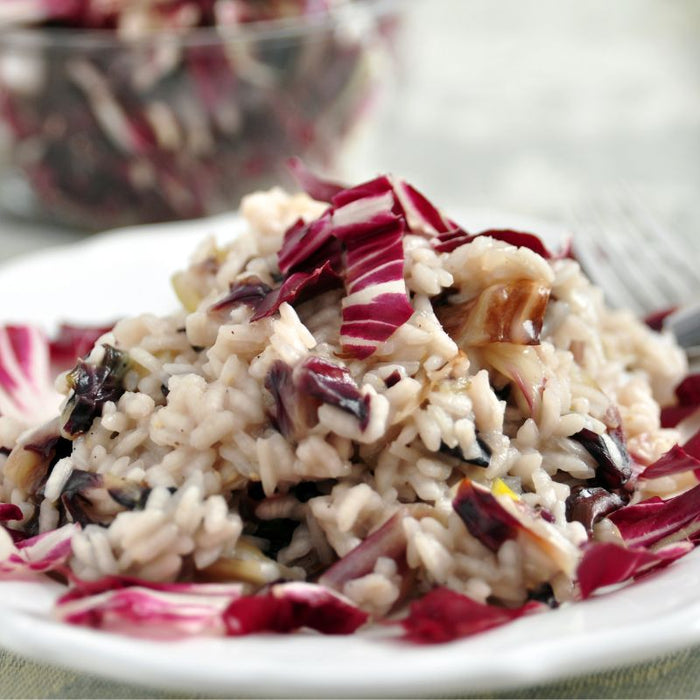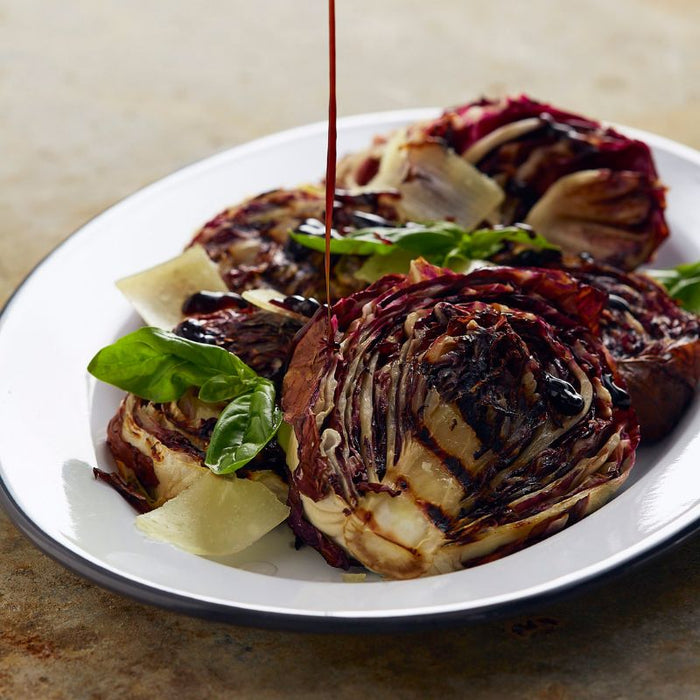
Radicchio - 1pc
Radicchio is a type of leafy vegetable that belongs to the chicory family. It is characterized by its vibrant burgundy or red color with white veins and a slightly bitter taste. Radicchio has a crisp texture and adds a distinct flavor to salads and various dishes.
Radicchio is commonly used in Italian cuisine, where it is a popular ingredient in salads, risottos, pasta dishes, and grilled preparations. It can be enjoyed both raw and cooked, offering different taste profiles depending on the preparation method.
Raw radicchio is often used in salads to provide a crisp and slightly bitter contrast to other ingredients. Its bold color and texture make it an attractive addition to mixed greens or as the main component of a salad. The bitterness can be balanced by pairing it with sweeter ingredients like fruits, nuts, or a tangy dressing.
When cooked, radicchio's bitterness tends to mellow out, and its flavor becomes more delicate. Grilling or roasting radicchio can bring out its natural sweetness and add smoky notes. Cooked radicchio can be served as a side dish, incorporated into pasta dishes, or used as a topping for pizzas and sandwiches.
Radicchio is not only known for its unique flavor but also for its nutritional benefits. It is a good source of vitamins, minerals, and antioxidants, making it a nutritious addition to your meals.
Overall, radicchio offers a distinct taste and visual appeal, making it a versatile ingredient that can elevate the flavors and presentation of various culinary creations.
How to eat radicchios?Radicchio can be enjoyed in a variety of ways, both raw and cooked, depending on personal preference and the dish you are preparing.
Here are a few common methods for eating radicchio:
1. Raw in salads: Radicchio is often used in salads to add a vibrant pop of color, texture, and a pleasant bitterness. Tear or chop the leaves into bite-sized pieces and combine them with other salad greens, such as lettuce or spinach. You can also add complementary ingredients like fruits (e.g., oranges, apples), cheese (e.g., blue cheese, goat cheese), nuts, and a flavorful dressing. The bitterness of radicchio can be balanced by the sweetness of other ingredients.
2. Grilled or roasted: Grilling or roasting radicchio can transform its flavor and texture. Cut the radicchio head into quarters, keeping the core intact to hold the leaves together. Drizzle the quarters with olive oil, season with salt and pepper, and grill or roast until the radicchio is slightly charred and softened. The heat mellows out the bitterness and brings out its natural sweetness. Grilled or roasted radicchio can be served as a side dish, added to sandwiches, or incorporated into pasta dishes.
3. Sautéed or stir-fried: Sautéing or stir-frying radicchio is another way to enjoy it. Heat some oil or butter in a pan, add sliced radicchio, and cook until it wilts and turns slightly tender. You can enhance the flavor by adding garlic, onions, or other seasonings of your choice. Sautéed radicchio can be served as a side dish, combined with other vegetables, or used as a topping for pizzas and bruschetta.
4. Stuffed or wrapped: Radicchio leaves can be used as edible cups for stuffing or wrapping other ingredients. Fill the leaves with grains, cooked meats, or other vegetables for a flavorful and unique appetizer or light meal. You can also use radicchio leaves as a substitute for tortillas or lettuce wraps.
Remember that radicchio has a distinct bitter taste, which can vary in intensity depending on the variety and freshness. If you find the bitterness too strong, you can soak the leaves in cold water for a few minutes before using them, which can help reduce the intensity.
Feel free to experiment and incorporate radicchio into your favorite recipes, exploring different cooking methods and flavor combinations to find your preferred way of enjoying this versatile vegetable.
Are radicchios low FODMAP?
Radicchio contains fructans, which are a type of oligosaccharide that can be difficult to digest for some people. However, the fructan content in radicchio is relatively low compared to other high-FODMAP foods.
During the elimination phase of the low FODMAP diet, it is recommended to limit radicchio consumption to a small portion, typically up to 1/2 cup or 75 grams. This is to ensure that the fructan content remains within the low-FODMAP threshold.
It's important to note that tolerances to FODMAPs can vary from person to person, and some individuals may be more sensitive than others. If you are following a low FODMAP diet, it's best to consult with a registered dietitian who specializes in the low FODMAP diet. They can provide personalized guidance and help you determine the appropriate portion sizes and overall FODMAP load to manage your specific dietary needs and symptoms.
















